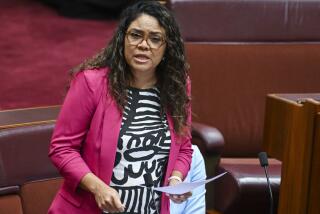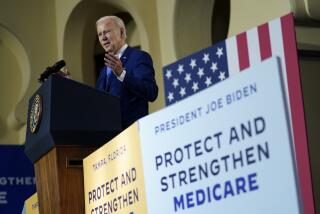Changing Lifestyles : Health Reform Has a Hold on Australia : System keeps costs down and has medical community’s support. Even conservatives say it’s here to stay.
- Share via
CANBERRA, Australia — The debate over health care now taking place in the United States elicits sympathetic nods in Australia, where a reform-minded government adopted sweeping change a decade ago. While the changes are still hotly debated, a key indication of the plan’s popularity is that even conservatives now accept that national health care is here to stay.
Before the plan was adopted, Australia was in many ways similar to the United States: The country had a strong tradition of private medical care along with public clinics to tend to the poor. About 17% of the population, the same proportion as in America today, had no health insurance.
The plan that was adopted in 1984, called Medicare, relied on both public health care and private medicine. Private doctors constitute an immensely powerful political lobby in Australia, so powerful that the federal constitution was amended to prevent Australia from following Britain in forcing doctors into a compulsory health care system.
By one measure, at least, the approach has been an unqualified success: holding down costs. Health care expenditures have risen from 7.4% of Gross Domestic Product in 1974 to just 8.5% of GDP today. The United States spends close to 14% of its GDP on health care.
“Interest groups apart, in fact Medicare keeps most people happy most of the time,” said John Deeble, one of the two principal architects of the plan. “There is a general perception that the system provides good access to quality medical care.”
Briefly put, Medicare is a publicly funded and administered universal insurance system to pay for doctor care. A national board was set up to manage the system, and it published a schedule of fees for every service that doctors provide. It pays 85% of the scheduled fee to a doctor.
“We have one health insurance system that supplies all payments in the country. It has saved hundreds of millions of dollars in the American context” of multiple private insurance companies, said Peter Botsman, executive director of the Evatt Foundation, a labor union think tank. “We have a better record of controlling prices than the English.”
Moreover, the system has the general support of Australia’s medical community. “We support the system’s universal coverage,” said Bill Coote, secretary general of the Australian Medical Assn., adding, however, that doctors would like the scheduled fees determined on a “more scientific basis” to take into account the costs of running a medical practice.
Medicare has two basic applications. On office visits, patients can choose a doctor. Hospital care is different; visits to public hospitals are free, but the patient has no choice of doctor. In a private hospital, the patient can choose the doctor, but virtually all doctors in such circumstances charge more than the scheduled fee.
If a patient chooses a doctor who charges more than the fee set by the government, the patient has to make up the difference. The Medicare law prohibits insurance for this gap, because the government believed that this would drive up prices.
Consider the case of a Sydney woman, Cathy Kell, whose second son developed non-Hodgkin’s lymphoma when he was 3 months old. He received hundreds of thousands of dollars of medical care in a specialist public pediatric hospital at no cost. “If we lived in America, we would have lost our house,” Kell recalled.
But when Kell’s third child was born, she opted for a private obstetrician because she wanted to choose the doctor. She and her husband paid the additional $600. She had the baby in a public hospital, where the delivery room was free, then moved to a private hospital because she preferred a private room rather than a hospital ward.
“The system’s got great flexibility,” she said.
The story illustrates one way in which Australia differs from the United States: Public hospitals are perceived to offer equal or better care than private institutions, which tend to focus more on amenities.
Because of intense competition for patients, many general practitioners in private practice came to the conclusion that it would be cheaper administratively to accept the scheduled fee and send all claims in at once. Known as “bulk billing,” the practice has been widely adopted, with the result that most visits to the doctor cost the patient nothing.
On the other hand, specialists are in relatively short supply, and few are willing to accept the scheduled fees. So in many cases of elective surgery, patients have to wait for a place at a public hospital.
A recently published survey showed that 43% of ear, nose and throat patients and 38% of orthopedic patients waited six months or more for surgery, while the average clearance time for patients needing general surgery was 1.3 months.
Those of sufficient financial means can go to a private hospital. While doctor care is not covered by private insurance, all the other amenities such as a private room and operating room can be covered.
One indicator of public acceptance of the Medicare plan is that the number of people with private insurance has plummeted in the decade since Medicare was adopted, from about two-thirds of Australia’s population to just one-third today. Indeed, the system may prove too popular--as more people drop their private health insurance the burden increasingly shifts to the public sector.
“If the public health care system fell off in quality, you’d find people increasingly prepared to pay for private care,” Deeble said. “There will always be some degree of difference between the two sectors. If the public system had all the trimmings, there wouldn’t be any private system.”
One hotly debated aspect of Medicare is costs. Australians pay 1.4% of their income as a Medicare fee, but even the system’s most enthusiastic supporters admit this a political sleight of hand to disguise the system’s true costs. The $2.4 billion this raises covers only 18% of Medicare’s expenses, with the remainder paid out of general tax revenue, contributing to Australia’s hefty top personal income tax rate of 49%.
The system realizes savings by minimizing administrative costs. It also squeezes public hospitals to keep costs to an absolute minimum, so high technology is used less frequently than in the United States. Some critics maintain that hospitals have been squeezed too much and that the quality of care has begun to suffer.
An earlier version of national health care, known as Medibank, was introduced in Australia in 1973 by a Labor government, but the plan was repealed when the Liberal party took power.
This time around, things are different. Perhaps responding to the public acceptance of Medicare in the opinion polls, Alexander Downer, leader of the Liberal opposition, conceded recently that if he takes power at the next election, Medicare would be left alone.
More to Read
Sign up for Essential California
The most important California stories and recommendations in your inbox every morning.
You may occasionally receive promotional content from the Los Angeles Times.










